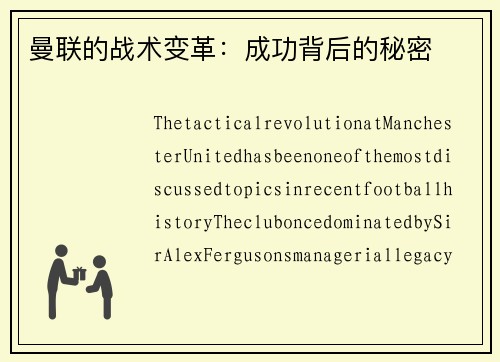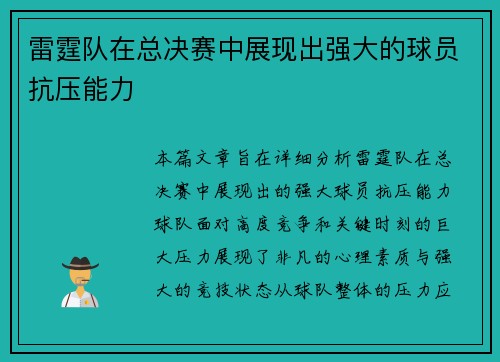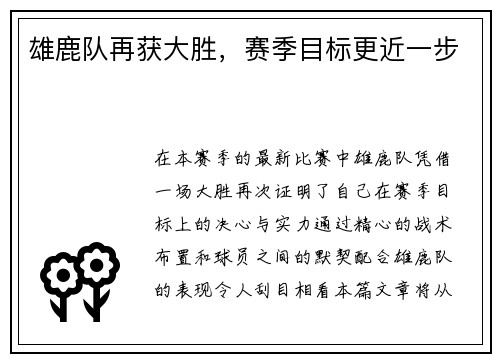The tactical revolution at Manchester United has been one of the most discussed topics in recent football history. The club, once dominated by Sir Alex Ferguson's managerial legacy, has undergone significant transformations over recent years. This article delves into the four key aspects of Manchester United's tactical evolution and uncovers the secrets behind their success. By analyzing the team's shift in strategic approach, player roles, formation changes, and manager influence, we can better understand how these tactical adjustments have contributed to their revival. Each section will explore one facet in depth, demonstrating how these transformations have shaped Manchester United's recent performance. Ultimately, this article will provide a comprehensive understanding of the tactical factors that have contributed to Manchester United’s success, helping us predict their future potential.
1、战术理念的根本变化
The first crucial aspect of Manchester United's tactical transformation is the shift in their overall football philosophy. Under the leadership of previous managers, such as Sir Alex Ferguson, the team played a free-flowing attacking game, often relying on individual brilliance to secure victories. However, recent managerial changes have seen a more structured and cohesive tactical approach being adopted. The current focus is on possession-based football, with an emphasis on controlling the game through the midfield and building attacks from the back. This fundamental change represents a departure from the direct style of play that characterized the team for decades. The integration of a more systematic game plan has allowed Manchester United to compete more effectively with top European teams that prioritize tactical discipline over raw attacking flair.
Under the influence of managers like Erik ten Hag, the club has begun to incorporate more advanced footballing philosophies, such as high pressing and positional play. This approach requires the players to be more disciplined, organized, and patient in their build-up play. The team’s defensive shape has also been altered, with an increased focus on maintaining solid structure and reducing the spaces between the defensive and midfield lines. This tactical change has made the team less vulnerable to counter-attacks and more adept at controlling the pace of the game. The result has been a significant improvement in Manchester United’s ability to dominate possession and create sustainable attacking opportunities throughout the match.
This strategic shift has also had a psychological impact on the players, who are now encouraged to play with more intelligence and awareness. The tactical change has instilled a sense of purpose and discipline within the squad, leading to a more cohesive and team-oriented performance. The combination of improved tactical understanding and physical discipline has contributed greatly to the team’s successes in recent seasons, allowing them to compete at a higher level in both domestic and international competitions.
熊猫体育官网首页入口2、阵型的灵活调整
The flexibility in Manchester United's formations has played a significant role in their tactical evolution. Historically, the club was known for its 4-4-2 and 4-3-3 formations, but under current management, there has been a greater emphasis on adaptability depending on the opponent and match situation. Erik ten Hag’s tactical versatility has allowed the team to switch between different formations, such as the 4-2-3-1 and 3-5-2, in order to exploit weaknesses in the opposition’s defensive setup. This fluidity enables the team to remain unpredictable and hard to prepare for, which is an essential aspect of modern football.
For example, when facing teams that deploy high pressing systems, Manchester United has frequently switched to a 3-5-2 formation. This provides extra protection in the central areas and allows the wing-backs to press forward, offering more width and attacking options. On the other hand, against teams with a more passive defensive setup, the team often resorts to a 4-2-3-1 formation, which allows for greater control of the midfield and more direct attacking play. The ability to fluidly transition between these setups has given Manchester United a tactical edge, enabling them to adjust their approach based on the context of each game.
This adaptability in formation is not only a reflection of the team’s tactical intelligence but also demonstrates the versatility of the players. Each player understands their role within different systems, which allows for seamless transitions during matches. This has been particularly beneficial in key moments, such as during crucial league games and knockout-stage competitions. The team’s ability to adapt to different styles of play has been instrumental in their recent successes, enabling them to navigate through challenging situations and secure important victories.
3、球员角色的多样化
Another critical element of Manchester United’s tactical success is the diversification of player roles within the team. Under Erik ten Hag, there has been a clear emphasis on developing players to perform multiple roles depending on the tactical setup. For instance, central midfielders like Bruno Fernandes and Christian Eriksen have been tasked with both creative playmaking and defensive responsibilities, contributing to the team’s balance in both attack and defense. This multifunctional role allows the team to remain fluid and versatile, with each player contributing to various aspects of the game.
Furthermore, the role of the full-backs has evolved significantly in recent seasons. Traditionally seen as defensive players, the modern full-back is now expected to contribute to the attack, providing width and crossing opportunities. Players like Luke Shaw and Diogo Dalot have embraced this role, frequently overlapping with the wingers and creating additional attacking outlets. This tactical development has given Manchester United greater depth in their offensive play, making them more dynamic and unpredictable going forward.
Additionally, the use of players in hybrid roles, such as deploying a winger as an inverted forward or a central defender as a ball-playing sweeper, has added another layer of complexity to Manchester United’s tactical approach. This flexibility allows the team to switch from a defensive posture to an attacking one seamlessly. The adaptability of individual players to these shifting roles is a testament to the club’s focus on tactical training and development, as well as the commitment to building a well-rounded and multifaceted team.
4、教练理念与管理影响
Finally, one of the most significant factors behind Manchester United’s tactical transformation is the influence of their current manager, Erik ten Hag. His philosophy and approach to football have shaped the team’s playing style and tactical discipline. Known for his commitment to possession-based football and high pressing, ten Hag has instilled a culture of hard work and tactical awareness in the squad. His ability to analyze matches, identify weaknesses, and implement targeted strategies has helped Manchester United navigate through tough competition in both domestic and international tournaments.
Ten Hag’s approach to team management has also had a profound impact on the players' mentality. He emphasizes the importance of collective effort over individual brilliance, fostering a sense of unity and cohesion within the squad. Under his leadership, Manchester United has shown a renewed focus on team spirit and cooperation, which has been a key factor in their tactical success. His managerial style is also evident in the way the team prepares for each match, with a clear emphasis on analyzing the opposition, understanding their strengths and weaknesses, and preparing a tailored tactical plan.
Moreover, ten Hag's influence extends beyond tactical instruction; his ability to motivate and communicate with his players has played a crucial role in their development. His focus on player development, both individually and collectively, has led to significant improvements in many areas of the team. Whether it is enhancing the defensive structure or encouraging more creativity in the final third, ten Hag’s management style has been instrumental in driving Manchester United's tactical revolution.
总结:

In conclusion, the tactical changes at Manchester United under Erik ten Hag have been a key factor in the club's recent successes. The evolution of their playing style, flexibility in formations, diversification of player roles, and the influence of their manager have all contributed to the team’s tactical growth. These changes have allowed the club to compete at a higher level, both domestically and internationally, and to challenge the traditional powerhouses in European football.
As Manchester United continues to develop and refine their tactical approach, the key to their future success will lie in maintaining this balance between structure and creativity. The ability to adapt to different styles of play, while maintaining tactical discipline and unity, will be essential in ensuring their long-term success. If these trends continue, Manchester United could return to the very top of European football, challenging for the biggest trophies year after year.



